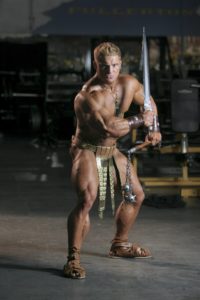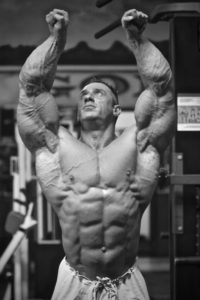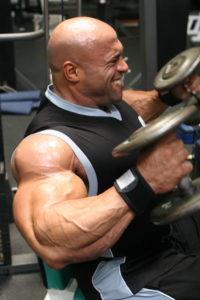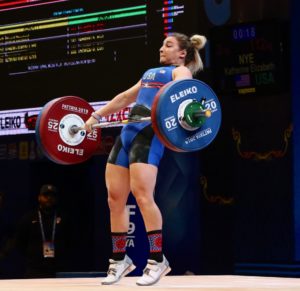
Canada’s leading strength coach discusses why bodybuilders and other athletes need grip training
By Strength Sensei CP
Publication Date: 1996
Before the machine era, grip work was performed extensively in the weight room. It was a time when bodybuilders and strength athletes proved their manhood with arm wrestling, and a time when knowing how much you could pinch grip was just as important as knowing how much you could bench press. Unfortunately, grip strength has been somewhat forgotten by many modern bodybuilders, who seem more concerned with how to get IGF-1 than how to make a strong impression with a firm handshake.
At present, mountain climbers are probably the most enthusiastic grip trainers. For these athletes, a strong grip can mean success or failure – or even survival! Others who will benefit from grip training include martial artists, law enforcement officers, powerlifters, and weightlifters. And although it may not seem like an important aspect of their training, bodybuilders also have much to gain from improving their grip.
The Bodybuilder’s Secret Weapon
Bodybuilders will benefit from grip work because it enables them to use heavier weights in mass-building back exercises, such as rows and chins. Heavier weights mean greater growth stimulation, and greater growth stimulation means bigger muscles.

A strong grip leads to impressive forearms. The victory pose, made popular by 2x Mr. Olympia Sergio Oliva, requires tremendous forearm development to pull off. Bodybuilding photos by Milos Sarcev.
I have seen many bodybuilders overcome a plateau in biceps training by adding direct grip and forearm work. When you include direct grip and forearm work, your curling poundages go up, which leans to enhanced biceps and brachialis development. IFBB Mr. America and strongman Chuck Sipes and 2x Mr. Olympia Larry Scott, pioneer bodybuilders who used tremendous weights in curling exercises, were strong supporters of this concept.
Direct grip work also helps hypertrophy the forearm muscles, giving more a more complete, symmetrical look to your arm development. Believe it or not, the forearms do grow! It is not uncommon to see bodybuilders gain at least ¼ inch on their forearms in as little as a month, just by doing grip work.

Direct grip and forearm work will increase your curling ability, leaning to gains in biceps and brachialis development.
Grip Training for Lifters and Law Enforcement
Olympic weightlifters know the value of a strong grip — many elite European athletes can lift as much as five percent more than their personal best when they use straps. In fact, when asked what their major criterion was for selecting athletes, Bulgarian weightlifting coach Angel Spassov replied, “Short athletes with big hands!”
To compensate for the smaller hands of women, the International Weightlifter Federation approved a smaller-diameter barbell for use in competition (2.5cm vs. 2.8cm). Unfortunately, this bar has not been approved for the smaller men, although it could make a big difference in performance. I recall a story about a Russian lightweight world champion from the 70s who supposedly experimented with a smaller diameter barbell; the first time he tried it, he was able to exceed his world record clean and jerk by 15 pounds!

A strong grip is essential to elite weightlifting performance. Shown is Katherine Nye, a US lifter who won the 2019 World Weightlifting Championships in the 71-kilo (156 pounds) bodyweight class. She broke a junior world record in the process, snatching 112 kilos (246 pounds). Photo by Tim Scott @liftinglife.
Powerlifters also need a firm grip to hold onto the bar when performing heavy singles in the deadlift. At competitions, powerlifters often drop the bar during a deadlift as they near lockout because of a weak grip. What a shame, because it is a problem that can be solved with just a few minutes a week of direct grip work. For powerlifters, grip work should be performed on the deadlift day as the last assistant exercise.
For martial artists, a strong grip is critical for high-level performance; in judo and wrestling, a strong grip is essential to acquire and maintain a hold on the opponent. Wrestler Claude Pilon was a bronze medalist in the heavyweight division at the Commonwealth Games. In his research for his master’s thesis in physical education, Pilon demonstrated that grip strength directly correlated with success in wrestling. In other words, you could predict the ranking of the various wrestlers at the Commonwealth Games by testing proficiency on the handgrip test.
In judo, gripping a Gi is a demanding task. Many judokas have suffered over the years from the trauma imposed to the fingers when their opponent breaks their grip. Tests performed on the Polish, French, Canadian, and Swedish judo teams revel that gripping strength is one of the essential predictors of international judo performance. Jujitsu necessitates a powerful grip to effectively perform the many pressure points, joint locking, and strangulation techniques their martial art contains.
Most law enforcement agencies teach hand-to-hand combat techniques. All these control techniques are dependent on a strong grip. (I also recently learned that most of these techniques were renamed to appear more benign when an officer has to testify in court; thus, Strangulation Technique #7 is now “Collar-Control technique #7.”)
There is also a trend in the special forces to use higher-caliber automatic pistols that require greater gripping strength – most hostage-rescue teams have already dropped the 9mm pistol because of its lack of power. Instead, the F.B.I. now uses a 10mm pistol, and the very successful G.I.G.N. from France prefers the .357 Magnum.
Many S.W.A.T. teams and special forces units, such as the British S.A.S., use a double-tapping technique when firing with the sidearm. That is, they will always fire at a target twice. Success with this firing skill comes from grouping the two bullets as close as possible for maximum lethal power. In this particular skill of shooting high-caliber weapons, higher gripping strength minimizes the forces created by the recoil of the firing weapon, thus allowing better precision and control of the succeeding shot. With these demands, it’s no wonder that gripping strength tests are used as part of the selection process for many of these organizations.
That’s my sales pitch on why you should not neglect grip training. In my next article, I will share with you a 6-week grip training program to give you a manly handshake and take your arm development to the next level.
